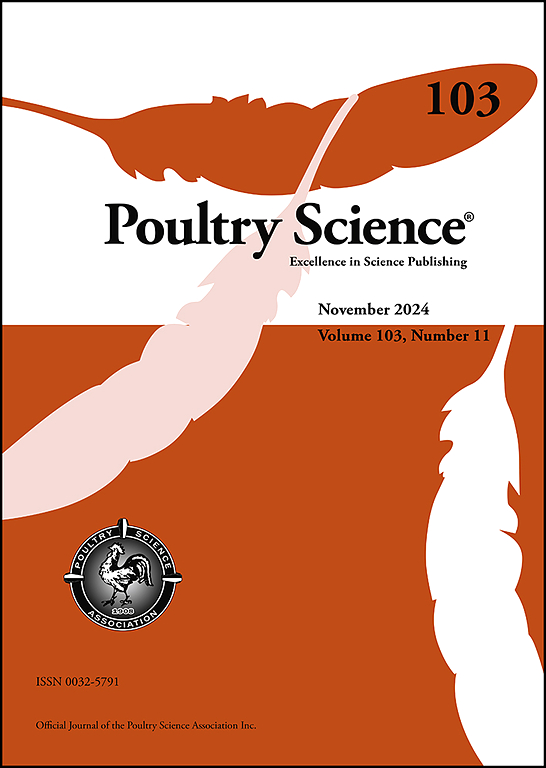基于wgna的转录组学和代谢组学整合揭示了靖远鸡发育过程中的关键肉质调节因子。
IF 4.2
1区 农林科学
Q1 AGRICULTURE, DAIRY & ANIMAL SCIENCE
引用次数: 0
摘要
靖远鸡以其独特的肉味而闻名,但不同发育阶段肉质动态变化的分子机制尚不清楚。本研究系统测量了42日龄、126日龄和180日龄靖远鸡的肉质指标,并利用加权基因共表达网络分析(WGCNA)整合转录组学和代谢组学数据,确定了肉质的关键调控因子。结果表明:126日龄和180日龄鸡的生长性能和屠宰性能显著优于42日龄鸡(P < 0.05),但42日龄鸡的屠宰率和半净膛率更高。随着日龄的增加,胸肌粗蛋白质、滴水损失和粗灰分含量显著增加(P < 0.05),含水量显著降低(P < 0.05)。WGCNA分析显示,在42日龄和126日龄组中,绿黄和蓝色模块与肉质指标呈极显著正相关(P < 0.01),其枢纽基因在PI3K - Akt信号通路、糖酵解/糖异生、脂肪酸代谢和氨基酸生物合成中显著富集。在42日龄和180日龄组,粉色和棕色模块与肉质指标呈显著正相关(P < 0.01), MAPK信号通路、AMPK信号通路和FoxO信号通路中心基因富集。在126日龄和180日龄组,品红模块与肉质指标呈正相关(P < 0.01), MAPK信号通路、Wnt信号通路、谷胱甘肽代谢和GnRH信号通路的枢纽基因富集。代谢组数据分析显示,在42日龄和126日龄组中,深灰色、钢蓝、sienna3和蓝色模块与肉质指标呈显著正相关(P < 0.05),其特征代谢物在组氨酸代谢、原胆汁酸生物合成和胆汁分泌方面显著富集。42日龄和180日龄组洋红色和青色模块与肉质指标呈极显著正相关(P < 0.05),其代谢产物丰富于鞘脂代谢、维生素B6代谢、产热代谢和嘌呤代谢。126日龄和180日龄组青色模块与肉质指标呈极显著正相关(P < 0.05),特征代谢物富集于氧化磷酸化、烟酸和烟酰胺代谢、维生素消化吸收和AMPK信号通路。最终筛选出与肉质密切相关的8个关键基因(SNORD14、IL7、HACD4、BFSP1、BCL6、FAM13A、ANKRD2和AGXT2)和5个关键代谢物(对甲酚硫酸盐、2 -辣椒酮、4 -羟基喹啉、琥珀酸和磷酸二羟丙酮)。本研究揭示了景远鸡肉品质的年龄依赖性调控机制。本研究为靖远鸡肉品质的遗传调控提供了有价值的见解,这可能为旨在提高家禽肉品质的育种计划提供信息。本文章由计算机程序翻译,如有差异,请以英文原文为准。
WGCNA-based integration of transcriptomics and metabolomics reveals key meat quality regulators during development in Jingyuan chickens
Jingyuan chickens are known for their unique meat flavor, but the molecular mechanisms underlying the dynamic changes in meat quality at different developmental stages remain unclear. In this study, we systematically measured the meat quality indicators of 42-, 126- and 180-day-old Jingyuan chickens, and integrated transcriptomic and metabolomic data using weighted gene co-expression network analysis (WGCNA) to identify key regulators of meat quality. The results showed that the growth and slaughter performance of 126- and 180-day-old chickens were significantly better than those of 42-day-old chickens (P < 0.05), but the slaughter rate and half-eviscerated rate of 42-day-old chickens were higher. With increasing age, the crude protein, drip loss, and crude ash content of the breast muscle increased significantly, while the water content decreased significantly (P < 0.05). WGCNA analysis revealed that in the 42- and 126-day-old groups, the greenyellow and blue modules were significantly positively correlated with meat quality indicators (P < 0.01), and their hub genes were significantly enriched in the PI3K - Akt signaling pathway, glycolysis/gluconeogenesis, fatty acid metabolism, and biosynthesis of amino acids. In the 42- and 180-day-old groups, the pink and brown modules were positively correlated with meat quality indicators(P < 0.01), and the hub genes were enriched in the MAPK signaling pathway, AMPK signaling pathway, and FoxO signaling pathway. In the 126- and 180-day-old groups, the magenta module was positively correlated with meat quality indicators (P < 0.01), and the hub genes were enriched in the MAPK signaling pathway, Wnt signaling pathway, glutathione metabolism, and GnRH signaling pathway. Metabolome data analysis showed that in the 42 - and 126 - day - old groups, the darkgrey, steelblue, sienna3, and blue modules were significantly positively correlated with meat quality indicators (P < 0.05), and their characteristic metabolites were significantly enriched in histidine metabolism, primary bile acid biosynthesis, and bile secretion. In the 42 - and 180 - day - old groups, the magenta and cyan modules were highly positively correlated with meat quality indicators (P < 0.05), and their metabolites were enriched in sphingolipid metabolism, vitamin B6 metabolism, thermogenesis, and purine metabolism. In the 126 - and 180 - day - old groups, the cyan module was highly significantly positively correlated with meat quality indicators (P < 0.05), with characteristic metabolites enriched in oxidative phosphorylation, nicotinate and nicotinamide metabolism, vitamin digestion and absorption, and the AMPK signaling pathway. Finally, eight key genes closely related to meat quality (SNORD14, IL7, HACD4, BFSP1, BCL6, FAM13A, ANKRD2, and AGXT2) and five key metabolites (p - Cresol sulfate, 2 - Piperidinone, 4 - Hydroxyquinoline, Succinic acid, and Dihydroxyacetone phosphate) were screened and identified. This study uncovers the age-dependent mechanisms regulating Jingyuan chicken meat quality. This study provides valuable insights into the genetic regulation of meat quality in Jingyuan chickens, which may inform breeding programs aiming to improve poultry meat quality.
求助全文
通过发布文献求助,成功后即可免费获取论文全文。
去求助
来源期刊

Poultry Science
农林科学-奶制品与动物科学
CiteScore
7.60
自引率
15.90%
发文量
0
审稿时长
94 days
期刊介绍:
First self-published in 1921, Poultry Science is an internationally renowned monthly journal, known as the authoritative source for a broad range of poultry information and high-caliber research. The journal plays a pivotal role in the dissemination of preeminent poultry-related knowledge across all disciplines. As of January 2020, Poultry Science will become an Open Access journal with no subscription charges, meaning authors who publish here can make their research immediately, permanently, and freely accessible worldwide while retaining copyright to their work. Papers submitted for publication after October 1, 2019 will be published as Open Access papers.
An international journal, Poultry Science publishes original papers, research notes, symposium papers, and reviews of basic science as applied to poultry. This authoritative source of poultry information is consistently ranked by ISI Impact Factor as one of the top 10 agriculture, dairy and animal science journals to deliver high-caliber research. Currently it is the highest-ranked (by Impact Factor and Eigenfactor) journal dedicated to publishing poultry research. Subject areas include breeding, genetics, education, production, management, environment, health, behavior, welfare, immunology, molecular biology, metabolism, nutrition, physiology, reproduction, processing, and products.
 求助内容:
求助内容: 应助结果提醒方式:
应助结果提醒方式:


